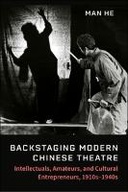Explore

Modern Chinese theatre once entailed a variety of forms, but now it primarily refers to spoken drama, or huaju. Backstaging Modern Chinese Theatre looks beyond scripts to examine visuality, acoustics, and performance between the two World Wars, the period when huaju gained canonical status. The backstage in this study expands from being a physical place offstage to a culturally and historically constructed social network that encompasses theatre networks, academies, and government institutions—as well as the collective work of dramatists, amateurs, and cultural entrepreneurs. Early huaju was not a mere imitation of Western realist theatre, as it is commonly understood, but a creative synthesis of Chinese and Western aesthetics. Charting huaju’s evolution from American colleges to China’s coastal cities and then to its rural hinterland, Man He demonstrates how the formation of modern Chinese theatre challenges dominant understandings of modernism and brings China to the center of discussions on transnational modernities and world theatres.
This book is included in DOAB.
Why read this book? Have your say.
You must be logged in to comment.
Rights Information
Are you the author or publisher of this work? If so, you can claim it as yours by registering as an Unglue.it rights holder.Downloads
This work has been downloaded 11 times via unglue.it ebook links.
- 11 - pdf (CC BY-NC) at OAPEN Library.
Keywords
- thema EDItEUR::A The Arts::AT Performing arts
- thema EDItEUR::A The Arts::AT Performing arts::ATD Theatre studies
- thema EDItEUR::N History and Archaeology::NH History::NHF Asian history
Links
DOI: 10.3998/mpub.12775372Editions

